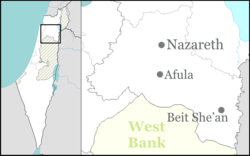Reshafim
| Reshafim | |
|---|---|
 | |
 Reshafim | |
| Coordinates: 32°28′53″N 35°28′38″E / 32.48139°N 35.47722°ECoordinates: 32°28′53″N 35°28′38″E / 32.48139°N 35.47722°E | |
| District | Northern |
| Council | Valley of Springs |
| Affiliation | Kibbutz Movement |
| Founded | 1948 |
| Founded by | Hashomer Hatzair members |
| Population (2015) | 734[1] |
| Website | www.reshafim.org.il |
Reshafim (Hebrew: רְשָׁפִים, lit. Sparks) is a kibbutz in northeastern Israel. Located two kilometres to the south of the town of Beit She'an in the Beit She'an Valley, it falls under the jurisdiction of Valley of Springs Regional Council. In 2015 it had a population of 734.
History
The community was established by Hashomer Hatzair members movement in 1947 at Kiryat Haim. In 1948 land was allocated from the state owned al-Ashrafiyya area south of Beit She'an whose Arab inhabitants had fled to Jordan as units of the Golani brigade approached during the night of 10–11 May during the 1948 Arab–Israeli War.[2] For the first few months at the site, the members of kibbutz Reshafim lived temporarily in a camp jointly with the members of kibbutz Shluhot which belonged to the Orthodox Religious Kibbutz Movement. The camp was later broken up when both kibbutzim were established adjacent to each other.
The founder members were mostly Holocaust survivors from Romania and Poland. They were joined by a small group of Israeli-born Sabras. In the 1950s a group of Argentine Jews and another group consisting mostly of Sephardic Jews joined the kibbutz. In the 1960s members were recruited from the Hashomer Hatzair youth movement and the Nahal from among the descendants of kibbutz members. With the decline of Western socialism and growing economic difficulties in the 1980s and 1990s population numbers stagnated.
Economy
At its inception Reshafim was a classical kibbutz where all the means of production belonged to the commune and members received equal shares of services, products, and money as remuneration. During the 1990s a process of privatization began, culminating in members receiving salaries and having to pay for services.
In 2007 the commune still owns a dairy, orchards, and a fresh-water fishery, is partner in a chickenfarm, and an agricultural co-operative and is part-owner of the Terraflex Industries plastics factory.[3]
References
- ↑ "List of localities, in Alphabetical order" (PDF). Israel Central Bureau of Statistics. Retrieved 16 October 2016.
- ↑ Benny Morris, The Birth of the Palestinian Refugee Problem Revisited, Cambridge University Press, 2004 p.227
- ↑ Terraflex Industries